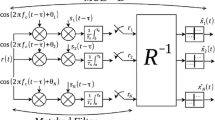Abstract
This paper addresses the practical implementation of Successive Interference Cancellation (SIC) for DS/CDMA systems. The practical aspects of such an implementation are discussed and a convenient pipelined architecture is presented. An important aspect is the integration of power control (PC) and interference cancellation which has synergistic effects of optimizing the SIC, reducing intercell interference, and facilitating the implementation.
Similar content being viewed by others
References
Alta Group of Cadence Design Systems, Inc., Signal Processing WorkSystem (SPW), SPW Software Release 3.1 documentation (June 1994).
R.M. Buehrer, N.S. Correal and B.D. Woerner, A comparison of multiuser receivers for cellular CDMA, in: Proc. of IEEE Global Telecommunications Conference Globecom '96, London, UK (November 1996) pp. 1571–1577.
F.C. Cheng and J.M. Holtzman, Effect of tracking errors on DS/CDMA successive interference cancellation, in: Proc. of Third Communication Theory Mini Conference in conjunction with Globecom '94, San Francisco, CA (November 1994) pp. 166–170.
D. Divsalar and M.K. Simon, Improved CDMA performance using parallel interference cancellation, in: Proc. of IEEE Military Communications Conference, Ft. Monmouth, NJ (October 1994) pp. 911–917.
A. Duel-Hallen, J.M. Holtzman and Z. Zvonar, Multiuser detection for CDMA systems, IEEE Personal Communications (April 1995) 46–58.
IA/TIA Interim Standard-95, Mobile Station - Base Station Compatibility Standard for Dual-Mode Wideband Spread Spectrum Cellular Systems (July 1993).
P. Hatrack and J.M. Holtzman, Reduction of other cell interference with integrated interference cancellation/power control, in: Proc. of 47th IEEE Vehicular Technology Conference, Phoenix, AZ (May 1997) pp. 1842–1846.
W.C. Jake, Microwave Mobile Communications (IEEE Press, 1994).
L.M.A. Jalloul and J.M. Holtzman, Performance analysis of DS/CDMA with noncoherent M-ary orthogonal modulation in multipath fading channels, IEEE Journal on Selected Areas in Communications 12(5) (June 1994) 862–870.
A. Kaul and B.D. Woerner, An analysis of adaptive multistage interference cancellation for CDMA, in: Proc. of 45th IEEE Vehicular Technology Conference, Chicago, IL (July 1995) pp. 82–86.
R. Kerr, CDMA digital cellular, An ASIC overview, Applied Microwave and Wireless (October 1993) 30–41.
L. Levi, F. Muratore and G. Romano, Simulation results for a CDMA interference cancellation technique in a Rayleigh fading channel, in: Proc. of 1994 International Zurich Seminar on Digital Communications, Zurich, Switzerland (March 1994) pp. 162–171.
G. Mazzini, Equal BER with successive interference cancellation DS/CDMA system on AWGN and Ricean channels, in: Proc. of IEEE International Symposium on Personal, Indoor and Mobile Radio Communications, Toronto, Canada (September 1995) pp. 727–730.
S. Moshavi, Multi-user detection for DS-CDMA communications, IEEE Communications Magazine 34(10) (October 1996) 124–136.
P. Patel and J.M. Holtzman, Analysis of a simple successive interference cancellation scheme in DS/CDMA system, IEEE Journal on Selected Areas in Communications 12(5), Special Issue on CDMA (June 1994) 796–807.
S. Verdu, Multiuser detection, in: Advances in Statistical Signal Processing, Vol. 2 (JAI Press Inc., 1993) pp. 369–409.
A.J. Viterbi, Very low rate convolutional codes for maximum theoretical performance of spread-spectrum multiple access channels, IEEE Journal on Selected Areas in Communications 8(4) (May 1990) 641–649.
Y.C. Yoon, R. Kohno and H. Imai, A spread-spectrum multi-access system with a cascade of co-channel interference cancellers for multipath fading channels, in: Proc. of International Symposium on Spread Spectrum Techniques and Applications, Yokohama, Japan (November 1992) pp. 87–90.
Author information
Authors and Affiliations
Rights and permissions
About this article
Cite this article
Seskar, I., Pedersen, K.I., Kolding, T.E. et al. Implementation aspects for successive interference cancellation in DS/CDMA systems. Wireless Networks 4, 447–452 (1998). https://doi.org/10.1023/A:1019193431680
Issue Date:
DOI: https://doi.org/10.1023/A:1019193431680




